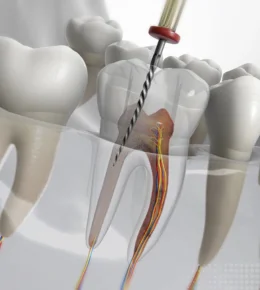Tooth root canal treatment
Root canal treatment is a dental procedure aimed at saving a tooth that has become infected or inflamed. This process involves removing the infected or damaged pulp from inside the tooth, cleaning and disinfecting the root canals, and then filling and sealing them with special materials. Root canal treatment is typically used to save teeth affected by deep decay, cracks, or other types of damage that have led to infection. This procedure can relieve pain and prevent further complications or the need for tooth extraction. While the appropriate term for this procedure is “root canal treatment” as it focuses on treating the damaged tooth, it’s commonly referred to as “nerve removal” because the tooth’s nerves are extracted during the process.

Types of tooth root canal treatment methods
One-session root canal treatment is a modern and efficient method in dentistry that completes all treatment steps in one session. And it is very suitable for people who have limited time.

Laser root canal treatment is an advanced procedure that cleans and disinfects root canals using lasers instead of traditional instruments, resulting in reduced pain, increased accuracy, and accelerated healing.

Microscopic root canal treatment is performed using a dental microscope to provide a better view of the root canals and increase the accuracy and efficiency of the treatment, which leads to better tooth preservation and reduced risks of mistakes.

Standard root canal treatment involves removing the damaged pulp, cleaning and disinfecting the root canals, and then filling and sealing them with special materials. This method is used to preserve the damaged tooth to prevent its extraction.






The stages of receiving services

Search for the service you want or choose from the available services.

In the appointment booking section, select and register your desired appointment.

After searching and registering your reservation, your confirmation will be announced via SMS and you can visit the clinic on the reserved date.
Some of your frequently asked questions
Root canal treatment is a treatment method used to save damaged and infected teeth. In this method, the living tissue of the tooth (such as nerve and pulp tissue) which is damaged, is removed and then the root canal of the tooth is cleaned and filled to heal the infection and save the tooth.
After root canal treatment, the following care is recommended:
Maintaining regular oral hygiene, including brushing twice a day and using dental floss.
Following a healthy diet and eating soft foods in the first days after treatment.
Carry out periodic inspections and contact the dentist in case of unusual symptoms such as pain or swelling.
The cost of root canal treatment depends on various factors, including the location of the desired tooth, the extent of the damage, etc. In general, the cost of this treatment can vary, but it is usually more expensive than other types of dental treatments. Contact our experts for more information.
Saving the damaged tooth and avoiding tooth extraction.
Reduce pain and infection.
Improving the function and appearance of teeth.
All about denervation
Dental denervation, root canal treatment, endo
Root canal therapy is a process in dentistry in which the dentist, after removing tooth decay, finds the tooth canals and drains the infection, nerves and capillaries inside the canal. In completing the steps of denervation, the dentist, after washing and cleaning the canals of the teeth, shapes them and fills them with gutta-percha. All terms like “root canal treatment,” “endodontic therapy,” “endo,” and “root canal therapy” refer to the same procedure, aimed at treating an infection in the tooth’s root. The first sign of a potential issue is usually pain or increased sensitivity to hot and cold. When this occurs, your dentist will typically recommend a specialized X-ray to evaluate the condition of the tooth. If the X-ray reveals an issue in the tooth’s root or nerves, or if the root has become infected or damaged, the dentist will suggest root canal treatment. This involves removing the infected nerves from the root canals to eliminate the infection.
Causes of damage to the tooth nerve
Root canal treatment is typically performed when the tooth pulp has suffered irreversible damage due to one of the following reasons:
Trauma or sudden injury to the tooth.
Decay of the tooth crown extending to the pulp or close to the pulp chamber.
Cracking or fracturing of the tooth.
Severe decay resulting from untreated cavities.
Multiple dental treatments on a single tooth.
Tooth injury, such as from a jaw impact.
Class 5 decay on the tooth neck, often caused by tobacco use.
This treatment helps to alleviate pain and prevent further damage to the tooth structure.
Steps of tooth denervation
Before starting the root canal procedure, the dentist first examines the patient’s teeth and uses X-rays to assess the extent of decay and damage. If the decay has reached the pulp and involves the nerve canals, the root canal treatment begins immediately. However, if there is an abscess, the dentist will prescribe antibiotics to reduce infection and inflammation before proceeding. After about 3 to 6 days, once the infection is under control, the root canal treatment can start. Antibiotics help reduce swelling and tooth pain, making the procedure smoother and more effective.
Nerve removal is usually done in the following steps:
Anesthesia Injection: The dentist injects a local anesthetic to numb the affected tooth and surrounding tissue, ensuring the patient feels no pain or discomfort during the procedure.
Locating the Nerve Roots: Using a dental drill, the dentist carefully drills through the tooth enamel and dentin to reach the pulp chamber and identify the entry points of the tooth’s canals.
Cleaning the Canals: The dentist uses specialized tools to thoroughly remove nerves, blood vessels, and any infection from the tooth’s canals.
Canal Irrigation: This crucial step involves thoroughly flushing the canals during each stage of the procedure to ensure they are clean and free from debris and infection.
Shaping channel dam: After emptying and washing the channels, it is time to shape it. Experienced dentists use a device called apex locator and rotary for this. Using this device reduces the percentage of error significantly.
6. Filling the canals: Finally, it is time to fill the empty space of the tooth nerve using a special substance called gutta-percha and sealer.
How is a denervated dental veneer?
Doctors often recommend a dental crown after a root canal procedure. A crown is a fixed cap that encases the restored and treated tooth, giving it an improved appearance. Beyond enhancing the look of the tooth, the crown serves to protect it. Since a tooth with no nerves, blood vessels, or blood flow is essentially a “dead” tooth, it becomes increasingly brittle over time. Placing a crown over the treated tooth increases its lifespan and durability.
Using a crown is especially important in the following cases:
If the tooth is fractured and has lost its natural structure.
If the dentist had to alter a large portion of the tooth.
If the tooth has been filled with dark materials.
Crowns provide essential reinforcement to root-canal-treated teeth, making them stronger and more resilient.
What is the infection of denervated tooth?
Infection in a previously root-canal-treated tooth is a rare occurrence but can happen for various reasons, typically within one to two weeks after the procedure. Signs of infection in a root-canal-treated tooth include pain and discomfort, abscess formation, swelling in the gums around the tooth, and a small pimple-like bump that discharges pus. In some cases, it may be necessary to redo the entire root canal procedure from the beginning. However, if the infection has spread and is causing harm to other teeth, extraction of the tooth might be required.
Care after denervation
• Do not eat chewable foods for 1 hour after the treatment.
• You may feel pain and discomfort in the root of the tooth for two weeks after the treatment. In this case, you can use painkillers.
• Swelling in the area of the tooth in question is normal. If you see it, see your dentist and avoid taking medicine without a prescription.
• You may feel pressure and pain when chewing for about a month after root canal treatment. This sensitivity decreases over time. If the pain persists or increases, see your dentist.
• The root-treated tooth is fragile. Cover the tooth and do not put pressure on it.
